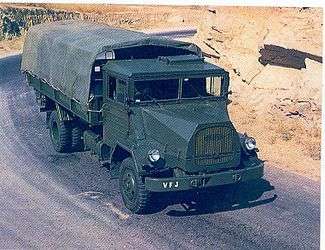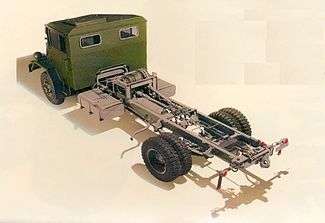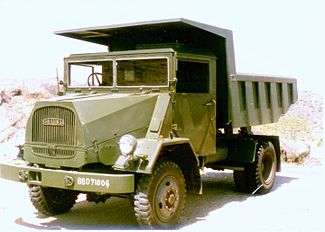Shaktiman truck
| Shaktiman | |
|---|---|
 Shaktiman truck manufactured by the VFJ | |
| Overview | |
| Manufacturer | Vehicle Factory Jabalpur |
| Also called | Shaktiman |
| Production | 1959 - 1996 |
| Body and chassis | |
| Class | Truck |
| Platform | MAN SE |
| Powertrain | |
| Engine | 6 Cylinders, in-line Diesel, Direct injection |
| Transmission | Clutch - Single plate, dry, dia 280 mm, Gear box = Constant mesh with 5 forward & 1 Reverse Forward Ratios 1:7.65/4.47/2.72/1.66/1.00 Reverse Ratio 1:6.86, Transfer Case Two speeds with lockable central torque split (inter Axle) different, Ratio = High 1:1, Low 1:1.755 , Composite (1-Beam and Drive Shafts) with two Stage reduction, Ratio = 1:6.2 |
| Chronology | |
| Successor | Ashok Leyland Stallion |
Shaktiman trucks were the most widely used medium-capacity trucks of the Indian Armed Forces. They were manufactured between 1959 and 1996 by the Vehicle Factory Jabalpur, (VFJ) of the Indian Ordnance Factories Board. Nearly all the Shaktimans have been phased out and replaced by Ashok Leyland Stallion and Tata LPTA 713 4x4s. Only about 7,000 Shaktimans remain compared to more than 60,000 Stallions MkIII and 28,000 Tata 713s. The Stallion MkIII itself is now being replaced by the Stallion MkIV
Over 75000 units were produced over its lifetime, of which about 7000 remained in active service as of 2009. They are now being replaced in the Indian Army by the Stallion Mk IV trucks.
Production
The first Shaktiman rolled off the production line at the Vehicle Factory Jabalpur (VFJ) motorvehicle factory in June 1958 under licence from the Indian Ordnance factories. The five ton Shaktiman VFJ 4X4 model was based on an early MAN original design and the first trucks were assembled using components from MAN-AG supplied by Germany. As production built up an increasing number of the components were supplied by Indian suppliers.
The final significant order for the trucks was received in 1993 from the Indian Army for 3000 trucks. This order was fulfilled by 1996. The infrastructure for the truck production was preserved for a few more years as a backup contingency option and in the unlikely event of more orders. The production line of Shaktiman was dismantled in 2003.
Shaktiman VFJ models were built on older design using all-steel cabs with easily flat angular surfaces to aid repairs and most used a multifuel 130 bhp engines with standard 4X4 axles. In total, over 75000 units of the truck in various configurations were produced for the Indian Armed Forces by VFJ over its lifetime.
Design and Development
The Shaktiman has a conventional truck design based on the MAN 415 L1 AR truck. One difference is that the Shaktiman has dual rear wheels. Over time, the design was customized and evolved by VFJ with the major focus being indigenisation, as well as to update it.[1] In the last few decades of its production, the trucks were being built entirely with components supplied by Indian vendors. (In fact what updates that were introduced, such as Ashok Leyland engines, were engineered by Ashok Leyland, and not VFJ)
Over time, a 4x4 drivetrain was added. The 4,000 kg 4x4 version is the most common version in active service. Other versions included ones with deeper chassis frames, heavy-duty suspension and larger tyres for a gross weightage of 8,350 kg and 11,000 kg.(Shaktiman always was 4x4)
Variants
| Variants | ||||||
|---|---|---|---|---|---|---|
|
The Shaktiman chassis was adapted into a wide range of variants, including:[1]
- 4x4 and 4x2 hard and soft top variants
- 4000 litre fuel tankers
- 4000 litre water tankers
- Versions for carrying shelter bodies, primarily for theatre communications and sensor systems
- Artillery tractors with crew shelters
- A version with gross weightage of 8350 kg for towing 105 mm light field guns and other howitzers
References
- 1 2 http://www.janes.com/articles/Janes-Military-Vehicles-and-Logistics/Shaktiman-4-x-4-4-000-kg-truck-India.html
External links
- Ordnance Factory Board of India's website on the Shaktiman
- Bharat Rakshak website on the Shatkiman truck

